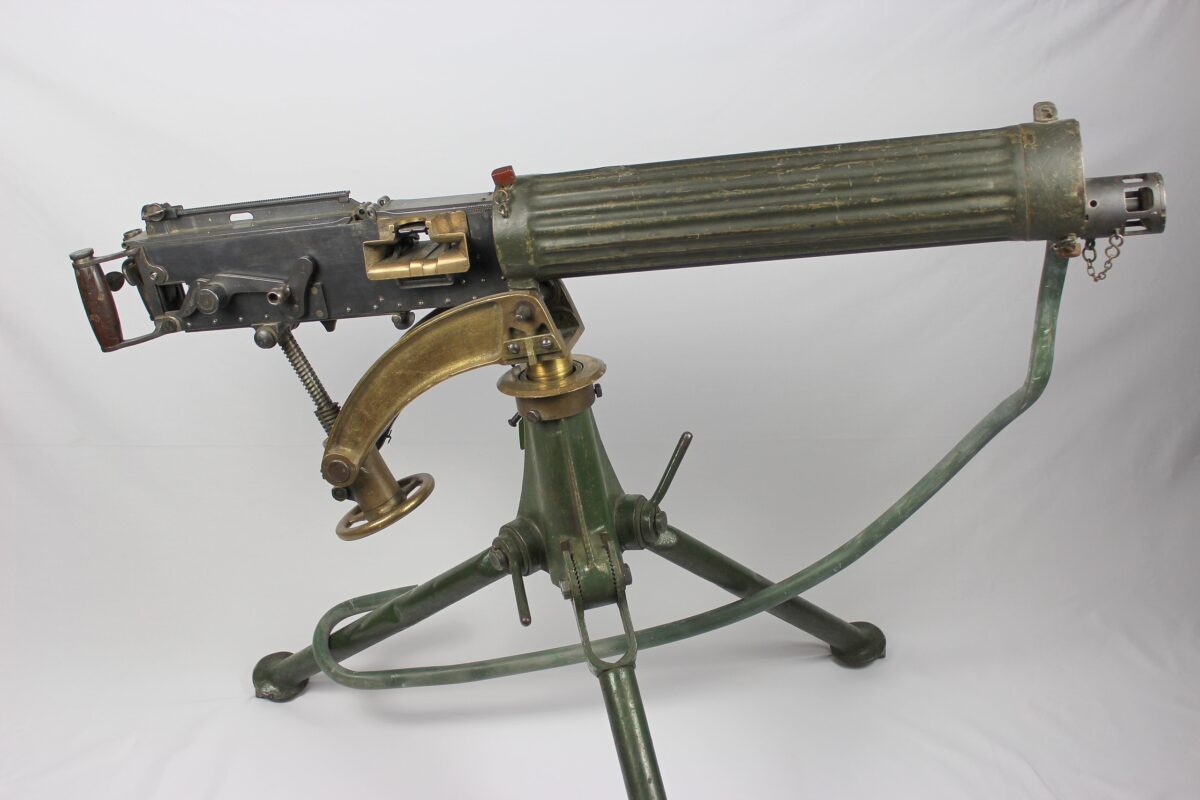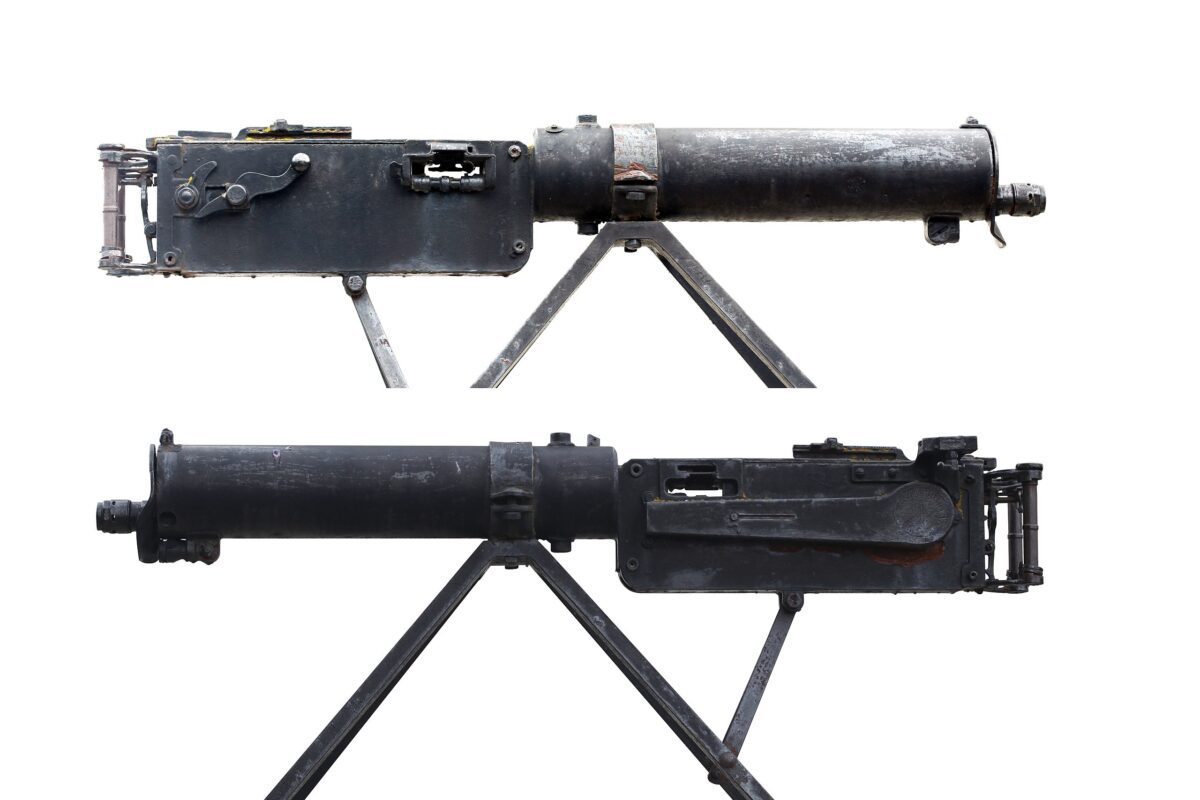The Maxim Gun Changed Warfare: Meet the Three Versions used in World War I – The First World War could arguably be seen as the greatest “family feud” of all time. Great Britain’s King George V was the first cousin to both Kaiser Wilhelm II of Germany and Empress Alexandria of Russia, via their grandmother Queen Victoria. Additionally, George V and Russia’s Czar Nicholas II, husband of Alexandria, were also first cousins as their mothers – Alexandra and Maria Feodorovna, princesses of Denmark – were sisters. Moreover, Nicholas and Wilhelm were third cousins, as both were great-great-grandsons of Paul I of Russia, but also second cousins once removed as they were descended from Frederick William III of Prussia.
Thus cousins George and Nicky sided against their cousin Willy in what to be the bloodiest and costliest war that Europe had seen to that point.
Yet, it wasn’t just the royal blood that was unique to these three nations. In addition to being linked via Queen Victoria of Great Britain, all three nations employed their own unique version of the weapon designed by American-born Hiram Maxim. The British had been among the first to employ the Maxim Gun, which proved so successful that it was widely adopted and derivative designs were used by Imperial Germany and Imperial Russia.
The British Vickers
The British may have been among the first to see the merits of the Maxim, but the British-based Vickers Limited also saw its limitations. That firm actually bought the Maxim Company outright in 1896 and took Hiram Maxim’s design and sought to improve upon it. That included inverting the recoil mechanism while at the same time reducing the weight by lightening and simplifying the action.
It took what had already been the first successful machine gun, and made it reliable and even a bit more mobile. Whereas many of the early Maxims utilized brass components, including the water jacket which gave the weapon an almost elegant look – the materials were heavy and impractical for a modern war. In fact, the first Maxim had been so heavy that it was typically mounted on a carriage, which meant the machine gun was employed like an artillery piece. That proved ideal as a defensive weapon, but the British Army was the first to see the merits of a more compact tripod – one that included folding legs and could be more easily transported by a military on the move.
Interestingly, the Vickers upgrade was not a quick process – and when the First World War broke out in August 1914 the British Territorial Forces – which the aforementioned Kaiser Wilhelm II even described as the “Contemptible Little Army” – was still equipped with older Maxims. The efforts were going so slowly that Vickers was even threatened with prosecution for war profiteering for increasing the price of the weapons when the war broke out. As a result the price was slashed, production was ramped up and the Vickers machine gun was rushed to the fronts.
Throughout the First World War, the Vickers was chambered for the .303 British cartridge that was employed in the Lee Enfield bolt action rifles, but later when the United States entered the war a variation was produced in .30-06 Springfield so that American units would also have a standard ammunition.

Vikers Machine Gun
The Vickers machine gun was also the first of the Maxim designs to feature a muzzle booster. It was still recoil operated however, albeit a refined design that provided a steadier rate of fire of 450 to 500 rounds per minute. It had an effective range of about 2,000 meters and a maximum range of 4,100 meters. It was employed on all fronts during the war and remained in service in a secondary role until the late 1960s – more than 50 years after the cousins of Europe went to war.
Imperial Germany’s MG08
Like the British, the Germans initially produced the Maxim under license, and it was domestically manufactured at Deutsche Waffen und Munitionsfabriken (DWM) in Berlin and by the government at its Spandau arsenal – the latter facility resulting in some describing it as a Spandau machine gun, but the official moniker was Maschinengewehr 08, or MG08.
It served as the primary heavy machinegun of the German Infantry Divisions. It had a practical range of 2,000 meters and an extreme range of 3,600 meters, which was more than enough to mow down advancing forces in no-man’s land.
The MG08, which was comprised of 235 parts – compared to the 144 of the Vickers – was originally employed on carriages, but at the outbreak of the war in August 1914 the machine gun was issued with a heavy “sledge” or “sled” mount – officially the “Schlitten 08.” Along with the nearly sixty-pound gun, the MG08 unit weighed nearly 140 pounds and that’s not counting the water can or boxes of ammunition. Today it is easy to look back and see this as impractical, but it was actually German efficiency at its finest.

MG 08
The sledge mount enabled a team of four to move the weapon along with its extra barrels, tools/cleaning kit and even oil containers at the same time. All that ensured that nothing could be forgotten or misplaced as it was literally attached to or carried on the sledge mount. Moreover, the sledge could be folded flat and two soldiers could carry it like a stretcher while the other two carried the water can and ammunition boxes.
The Germans attempted to develop a portable version, the MG08/15, which featured a small bipod, was fitted with a shoulder stock and could be used with a fixed drum magazine. The weapon was portable – at least in that two soldiers could advance with it.

MG 08
The MG08 remained in a secondary role in the Second World War.
Imperial Russia’s M1910
Officially known as Pulemyot Maxima obraztsa 1910 goda (“Maxim’s machine gun Model 1910”), or M1910, was Russia’s version of the Maxim. Chambered for the 7.62x54mmR round, the same as the Mosin Nagant M1890 rifle, this version differed in that it was mounted on a wheeled Sokolov mount (sometimes with gun shield), which made the medium machine gun easier to move.
The original versions of the Imperial Russian M1910s were fitted with smooth brass water jackets, but by the outbreak of the First World War, smooth stamped steel jackets were produced. Russian industry struggled to produce enough of the machine guns during the war.
The February Revolution of 1917 saw the Czar removed from power, while the October Revolution threw the country into Civil War. Both pro-Czarist Whites and the Bolshevik’s Red Army employed the M1910. In fact, from 1918 to 1920, some 21,000 were produced – more than had been made by the Imperial Russian arsenals. Production continued after the Civil War, and only ceased in 1939. It was restarted in 1940 and in total at least 175,000 were produced.

M1910 Machine Gun
The M1910 was employed as a secondary/defensive weapon during the Second World War, and later saw service in the Chinese Civil War, the Korean War, and even Vietnam. Some M1910s have even been reported to have been employed in Syria in its ongoing Civil War. It certainly had a better run than the reign of Nicholas II!
MORE: Is Russia’s Su-57 Felon Stealth Fighter a Total Bust?
MORE: Merkova: Israel Has A Super Tank
Peter Suciu is a Michigan-based writer who has contributed to more than four dozen magazines, newspapers and websites. He regularly writes about military small arms, and is the author of several books on military headgear including A Gallery of Military Headdress, which is available on Amazon.com. Peter is also a Contributing Writer for Forbes Magazine.

